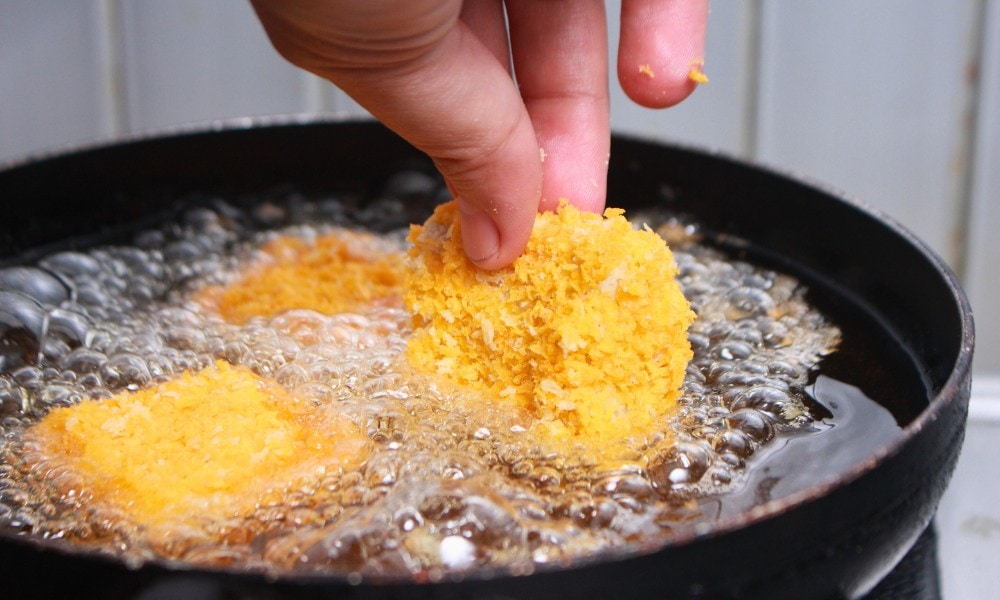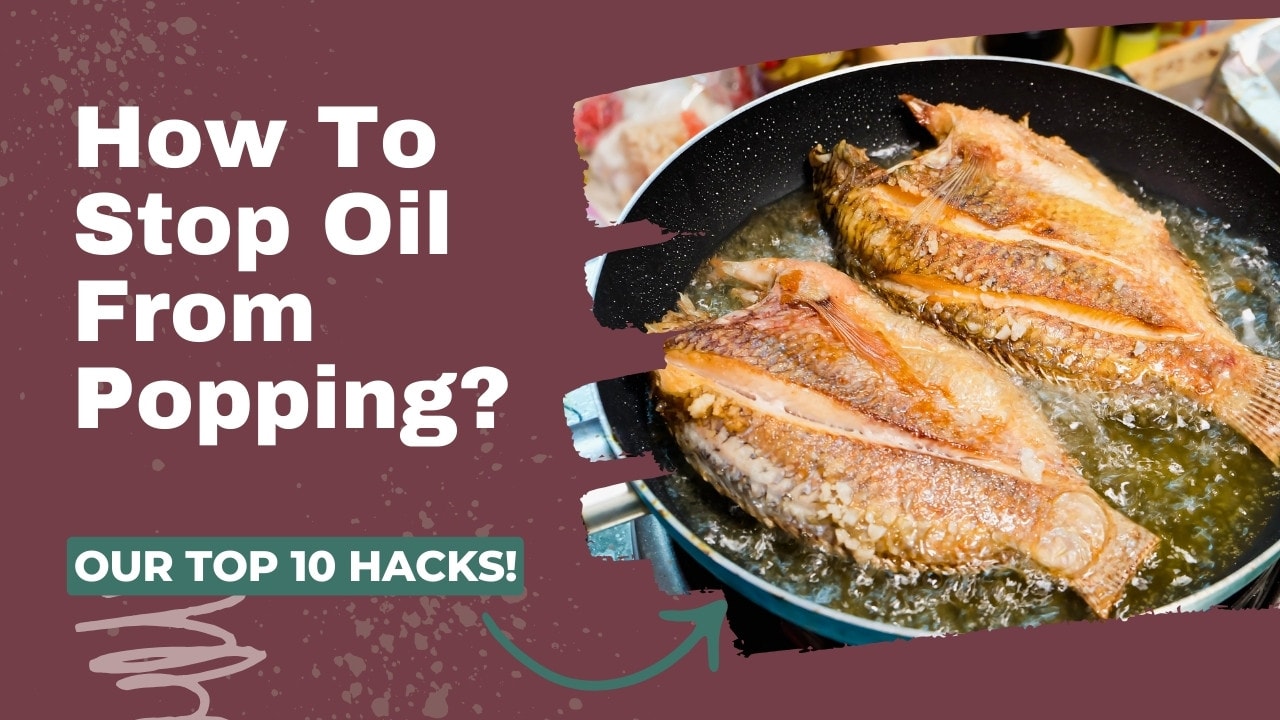When cooking with hot oil, we know what to expect! We brace ourselves for the hot spray that spits over our cook space, making a mess. In worst-case scenarios, it scorches our skin and marks our clothes with stains we’ll never get out.
But if you understand the mechanics of how and why oil splatters, you can take preventative measures so that cooking with oil doesn’t have to be a messy or painful experience. Our guide offers everything you need to know about how to stop oil from popping.
How Do You Stop Oil from Splattering?
Hot oil can pop when it comes into contact with water droplets from your food. You can help avoid splattering by thoroughly drying your food before placing it into the oil. You can also try adding a sprinkle of salt at the bottom of the pan to soak up any moisture and minimize popping.
One of the best ways to prevent a slick mess on your stovetop is to use a splatter screen or lid while frying. This will act as a barrier to prevent popping oil from spraying all over your kitchen..
Tips and Q&A For Safe and Splatter-Free Frying
1. What sort of pan is best/safest for pan frying or deep frying?
If you’re pan frying, you’ll want a deep, heavy-bottom pan with thick walls made from a material that retains heat well, such as stainless steel, cast iron (enameled or not), or cast aluminum.
For deep frying, you’ll need something with high sides (at least 3” deep) and secure handles, such as a cast iron Dutch oven. You can also get away with using a wok. The induction-compatible fry pan in the video below is a good example of a suitable pan for deep frying.
2. Should you let the pan heat up before adding oil?
There is debate about whether or not to heat the pan before adding oil. Some say it depends on what kind of pan you’re using. Heating a cast iron or carbon steel pan before you add oil will prevent the oil from breaking down before the food is added. This is believed to coat the pan, allowing it to come to an even temperature that prevents smoking or popping.
Others say you can add oil to the pan without heating it first, especially when using a nonstick pan. Nonstick pans are already coated and ready to cook evenly. Either way, you’ll want to consider the smoke point of your oil, and not allow your oil to heat to smoking before adding food.
3. What Temperature Should the Oil Be?
Popping oil is often a sign that your oil is too hot. Deep frying requires oil to be brought to 350°F to 375°F. Different recipes also have varied temperature requirements. So, you’ll want to stick to those while taking additional precautions to prevent splatter.
How Do You Tell the Right Oil Temperature for Frying? Do You Need a Thermometer?
Heated oil in a pan should give off a glugging noise with a gentler bubble rather than a rapid, violent movement and crackling sound.
You could also try placing the end of a wooden spoon into your oil. If bubbles start to form around the spoon, then the oil is a suitable temperature for splatter-free frying. If you see a tumultuous rumble, the oil is probably too hot.
Neither of these methods is as accurate and reliable as using a food thermometer, though!
4. Does the smoke point of the oil make a difference?
The perfect temperature to prevent oil popping depends on your oil. Different types of oils have different smoke points or temperatures they can reach before they start to smoke and break down.
For example, butter reaches its smoke point between 300°F and 350°F, so it will likely overheat before it reaches the temperature needed for deep frying. It’s best to use oil with higher smoke points to prevent it from getting too hot when frying. Oils with lower smoke points can quickly break down and pop at lower temperatures.
Here’s a quick reference guide listing common oils and their smoke points.
5. Does adding salt to a pan help prevent splatter?
It’s become a famous Tik Tok hack: Adding salt to a pan is said to help absorb water droplets from your food and lessen oil popping. While it might not help remove all splatter, many who tried this trick found that it helped reduce the popping.
6. How much oil is the right amount to avoid popping or splattering?
Too much or too little oil in your pan can create splatter. You’ll want to fill your pot two-thirds of the way with oil when deep frying. When pan frying, just use enough oil to create a film between the food and your pan. Different foods absorb oil at different rates, so you may need to adjust the amount of oil you use depending on your recipe.
However, all foods absorb more oil and get soggy if the oil is not hot enough when you’re frying. So if your ingredients are sucking up a lot of oil, make sure the temperature isn’t the problem before adding more.
7. Dry the Food Before Adding It
Yes! It’s critical to pat your food dry to remove the water droplets on your food before adding it to the oil. Water expands into steam when it touches hot oil, which sends the oil flying into a splatter. Moisture on your food will also cause the oil temperature to drop more drastically. Use a paper towel to blot food dry before adding it, especially if frying something frozen, like chicken wings.
8. Don’t Crowd the Pan
Avoid adding too much food to your deep fryer. Placing too much food inside a deep fryer can cause the oil’s temperature to drop and prevent the food from cooking properly.
It takes more time, but you’ll get much better results if you fry in smaller batches. Foods should be submerged when deep frying and have a fair amount of space in between pieces.

9. Use a Splatter Guard
Splatter guards keep the mess in the pan while allowing steam to escape. They also help protect you from free-flying hot oil that could burn you. Some are made from a screen mesh and go right on top. Others are made from silicone and go over the pan in a cone shape so you can access your food while still being protected from splatter.
10. Should you deep fry with the lid on or off?
Some people suggest using a lid while you deep fry for safety reasons. But Chef Kim Kenig says using the lid traps steam and defeats the point of deep frying. As food cooks, it releases moisture, which creates condensation on the lid that will drip into your pan – causing, of course, oil to pop! Using the lid makes it harder to monitor frying progress, and it can steam instead of fry your food.
Frequently Asked Questions
What Makes Oil Pop in a Pan?
Hot oil pops when it comes into contact with water. The phenomenon is known as “steam explosion.” The high temperature of the oil causes the water to rapidly vaporize and expand, leading to tiny explosions or “pops.”
Is Oil Supposed to Crackle?
You should expect a reasonable crackling or sizzling sound when adding food to frying oil. But if it starts to become rapid and intense, there could be a problem with the amount of moisture in your food or the temperature of your oil.
What Does It Mean When Oil Bubbles in a Pan?
Mild bubbles appearing in oil in a pan simply means that it’s heating and ready for food. But intense boiling, or foaming oil, indicates that oil is at its boiling point – well past its smoke point– and is breaking down, releasing volatile compounds in the process! And yes, fats and oils will boil, but only at higher temperatures than water.
Does Salt Stop Oil From Popping?
Adding salt to your pan when deep frying will not completely stop the oil from popping. Adding some salt to a pan before you add your food can, however, help to reduce popping.
Conclusion
Hopefully, you can say goodbye to cleaning up greasy stovetops and those tiny little burns after mastering our tips on how to stop oil from popping.
Is there anything about this topic we missed, or would you like to add? Tell us in the comments. If we’ve covered it all, please share this article with your fellow home fryers!









